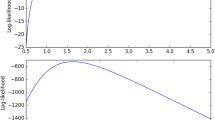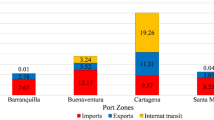Abstract
This paper presents a new method for estimating regional trade flows using transportation survey data describing commodity origin–destination flows. Explicit attention is paid to the difference between commodity flows and trade flows that arises from the presence of transhipment points. Observed commodity flows in the transportation survey data are converted to production–consumption trade flows that are consistent with the multi-regional input–output framework. Regional trade flow estimates are then reconciled with regional production and consumption estimates using a mathematical program that aims to make minimal adjustments while imposing known multi-regional input–output accounting identities. It is shown that commodities originating or terminating at a transhipment point should be reassigned to their probable production origins or consumption destinations as long as an unbiased sample of previous observations is available. As the number of observations increases, the prediction error of the production origin or consumption destination decreases exponentially. A real-world case study in the Province of Ontario in Canada demonstrates the feasibility of estimating interregional trade flows from commercial vehicle survey data and shows that the estimated pattern of trade flows is maintained after adjustments are made to satisfy accounting constraints. Therefore, it is possible to create a balanced multi-regional input–output model based on a commercial vehicle survey and the limited supplementary data available at the regional level.






Similar content being viewed by others
Notes
See Rose (1995) for a discussion on the relationship between IO and computable general equilibrium (CGE) models.
RAS is not an acronym—the method is named after the right-hand side of an equation. It is also known as “bi-proportional” matrix balancing.
For example, Alward et al. (1998), Lindall et al. (2006), Schwarm et al. (2006), Jackson et al. (2006), and Park et al. (2009) use the Commodity Flow Survey (CFS) from the US Census Bureau and the Bureau of Transportation Statistics (BTS) to estimate trade flows; Al-Battaineh and Kaysi (2005) use the Ministry of Transportation of Ontario (Canada) Commercial Vehicle Survey (CVS) to estimate commodity flows.
Instead of using optimization to estimate trade flows between regions, Al-Battaineh and Kaysi (2005) use optimization to estimate truck flows between regions.
The appendix in supplementary material shows how this objective function can be easily translated into a standard quadratic program in matrix form [\(\min f\left( x \right) =\frac{1}{2}\mathbf{x}^{\mathrm{T}}\mathbf{Hx}+\mathbf{f}^{\mathrm{T}}\mathbf{x}\)].
Canning and Wang (2005) show how imposing accounting relationships (as in step two) will definitely improve, or at least not worsen the initial estimates, since those constraints are identities and must be true for any system of economic regions.
Miller and Blair (2009) discuss how observed national technology is often assumed uniform across regions and the conditions that make this assumption reasonable.
Alternatively, Fig. 3 could be interpreted as commodity flows involving a transhipment point at the origin. In this case, the x-axis contains the number of observations of commodities previously made that enter the transhipment point, and the y-axis contains the error created when predicting the origin of future commodities leaving the transhipment point.
A distribution center serving all regions equally is the worst case scenario because it is the hardest to predict from a sample of observations for the same reason the outcome of a fair coin is harder to predict than the outcome of a biased coin: it is more random.
Make and Use tables for the province of Ontario are also based on NAICS, but both the employment and input–output data make different aggregations of NAICS requiring a correspondence between the classifications as shown in Table A1 in the appendix of supplementary material.
A correspondence was established with Statistics Canada commodity groupings as given in Table A2 in the appendix of supplementary material.
The number of observations in the MTO CVS of commodities originating (or terminating at) distribution centers and truck terminals in Toronto with known consumption destinations (or production origins) is given in Table A3 in the appendix of supplementary material.
References
Al-Battaineh O, Kaysi IA (2005) Commodity-based truck origin destination matrix estimation using input–output data and genetic algorithms. Transp Res Rec J Transp Res Board 1923:37–45
Alward G, Olson D, Lindall S (1998) Using a double-constrained gravity model to derive regional purchase coefficients. In: Paper presented at the 1998 Regional Science Association International Meeting, Sante Fe, New Mexico
Bachmann C, Kennedy C, Roorda MJ (2014) Applications of random-utility-based multi-region input–output models of transport and the spatial economy. Transp Rev Transnatl Transdiscipl J 34(4):1–23
Ben-Akiva ME, de Jong G (2008) The aggregate-disaggregate-aggregate freight model system. In: Ben-Akiva M, Meersman H, Van de Voorde E (eds) Recent developments in transport modelling. Emerald Group Publishing Limited, Bingley
Buera FJ, Kaboski JP (2012) The rise of the service economy. Am Econ Rev 102(6):2540–2569
Canning P, Wang Z (2005) A flexible mathematical programming model to estimate interregional input–output accounts. J Reg Sc 45(3):539–563
Herrero RÁ, García AS, Carvajal CR (2002) Spatial projection of input–output tables for small areas. In: Paper presented at the 42nd Congress of the European Science Association, Dortmund, Germany
Jackson RW, Schwarm WR, Okuyama Y, Islam S (2006) A method for constructing commodity by industry flow matrices. Ann Reg Sci 40(4):909–920
Lee C (1973) Models in planning: an introduction to the use of quantitative models in planning. Pergamon Press Ltd, Oxford
Lee B, Park JY, Gordon P, Moore JE II, Richardson HW (2012) Estimating the state-by-state economic impacts of a foot-and-mouth disease attack. Int Reg Sci Rev 35(1):26–47
Lenzen M, Kanemoto K, Moran D, Geschke A (2012a) Mapping the structure of the world economy. Environ Sci Technol 46(15):8374–8381
Lenzen M, Moran D, Kanemoto K, Foran B, Lobefaro L, Arne Geschke A (2012b) International trade drives biodiversity threats in developing nations. Nature 486:109–112
Lindall S, Olson D, Alward G (2006) Deriving multi-regional models using the implan national trade flows model. J Reg Anal Policy 36(1):76–83
Maoh H, Kanaroglou P, Woudsma C (2008) Simulation model for assessing the impact of climate change on transportation and the economy in Canada. Transp Res Rec J Transp Res Board 2067:84–92
Miller RE, Blair PD (2009) Input–output analysis: foundations and extensions. Cambridge University Press, Cambridge
Nakano S, Nishimura K (2013) A nonsurvey multiregional input–output estimation allowing cross-hauling: partitioning two regions into three or more parts. Ann Reg Sci 50(3):935–951
Parilla J, Berube A (2013) Metro North America: cities and metros as hubs of advanced industries and integrated goods trade. Brookings Institution, Washington
Park JY, Gordon P, Moore JE II, Richardson HW (2009) A two-step approach to estimating state-to-state commodity trade flows. Ann Reg Sci 43(4):1033–1072
Ramos P, Sargento A (2003) Estimating trade flows between Portuguese regions using an input–output approach. In: Paper presented at the 43rd Congress of the European Regional Science Association, Finland
Rose A (1995) Input–output economics and computable general equilibrium models. Struct Change Econ Dyn 6(3):295–304
Sargento ALM, Ramos PN, Hewings GJD (2012) Inter-regional trade flow estimation through non-survey models an empirical assessment. Econ Syst Res 24(2):173–193
Schwarm WR, Jackson RW, Okuyama Y (2006) An evaluation of method for constructing commodity by industry flow matrices. J Reg Anal Policy 36(1):84–93
Statistics Canada (2014) Table 203-0025—survey of household spending (SHS), household spending, by size of area of residence, CANSIM (database). http://www5.statcan.gc.ca/cansim/. Accessed 29 Jan 2014
Wiedmann T, Lenzen M, Turner K, Barrett J (2007) Examining the global environmental impact of regional consumption activities—Part 2: review of input-output models for the assessment of environmental impacts embodied in trade. Ecol Econ 61(1):15–26
Author information
Authors and Affiliations
Corresponding author
Electronic supplementary material
Below is the link to the electronic supplementary material.
Rights and permissions
About this article
Cite this article
Bachmann, C., Kennedy, C. & Roorda, M.J. Estimating regional trade flows using commercial vehicle survey data. Ann Reg Sci 54, 855–876 (2015). https://doi.org/10.1007/s00168-015-0689-6
Received:
Accepted:
Published:
Issue Date:
DOI: https://doi.org/10.1007/s00168-015-0689-6




